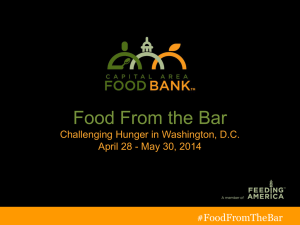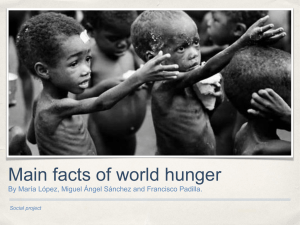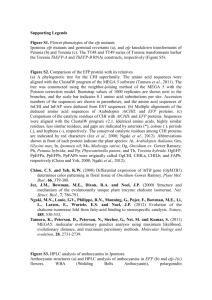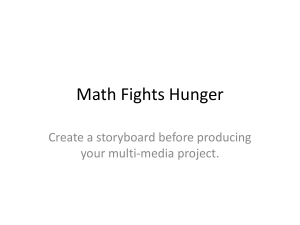Beyond the Canned Food Drive Program Bank
advertisement
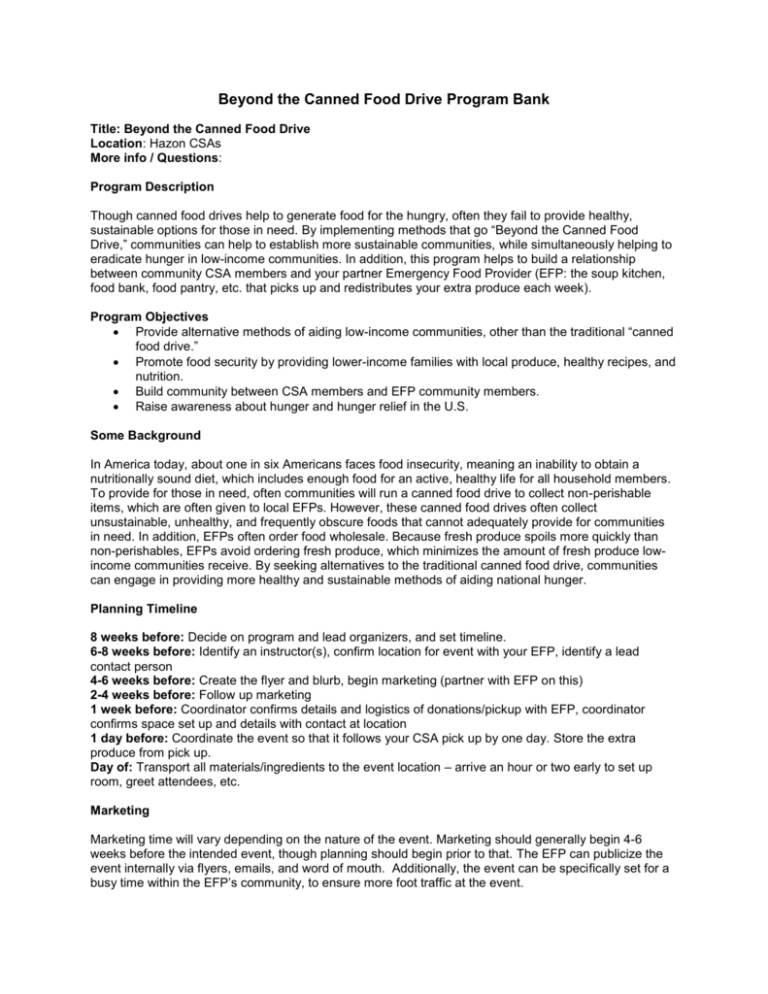
Beyond the Canned Food Drive Program Bank Title: Beyond the Canned Food Drive Location: Hazon CSAs More info / Questions: Program Description Though canned food drives help to generate food for the hungry, often they fail to provide healthy, sustainable options for those in need. By implementing methods that go “Beyond the Canned Food Drive,” communities can help to establish more sustainable communities, while simultaneously helping to eradicate hunger in low-income communities. In addition, this program helps to build a relationship between community CSA members and your partner Emergency Food Provider (EFP: the soup kitchen, food bank, food pantry, etc. that picks up and redistributes your extra produce each week). Program Objectives Provide alternative methods of aiding low-income communities, other than the traditional “canned food drive.” Promote food security by providing lower-income families with local produce, healthy recipes, and nutrition. Build community between CSA members and EFP community members. Raise awareness about hunger and hunger relief in the U.S. Some Background In America today, about one in six Americans faces food insecurity, meaning an inability to obtain a nutritionally sound diet, which includes enough food for an active, healthy life for all household members. To provide for those in need, often communities will run a canned food drive to collect non-perishable items, which are often given to local EFPs. However, these canned food drives often collect unsustainable, unhealthy, and frequently obscure foods that cannot adequately provide for communities in need. In addition, EFPs often order food wholesale. Because fresh produce spoils more quickly than non-perishables, EFPs avoid ordering fresh produce, which minimizes the amount of fresh produce lowincome communities receive. By seeking alternatives to the traditional canned food drive, communities can engage in providing more healthy and sustainable methods of aiding national hunger. Planning Timeline 8 weeks before: Decide on program and lead organizers, and set timeline. 6-8 weeks before: Identify an instructor(s), confirm location for event with your EFP, identify a lead contact person 4-6 weeks before: Create the flyer and blurb, begin marketing (partner with EFP on this) 2-4 weeks before: Follow up marketing 1 week before: Coordinator confirms details and logistics of donations/pickup with EFP, coordinator confirms space set up and details with contact at location 1 day before: Coordinate the event so that it follows your CSA pick up by one day. Store the extra produce from pick up. Day of: Transport all materials/ingredients to the event location – arrive an hour or two early to set up room, greet attendees, etc. Marketing Marketing time will vary depending on the nature of the event. Marketing should generally begin 4-6 weeks before the intended event, though planning should begin prior to that. The EFP can publicize the event internally via flyers, emails, and word of mouth. Additionally, the event can be specifically set for a busy time within the EFP’s community, to ensure more foot traffic at the event. It is best to coordinate many of these alternatives more in advance than a canned food drive would normally require. Often these alternatives require advanced coordination between your community and a CSA and/or EFP than a traditional canned food drive would require. 11 Alternatives to the Traditional Canned Food Drive: Some of the alternatives can be implemented in place of the traditional canned food drive that occurs at the same time as a community event. Some of the events can be used to take the place of the traditional canned food drive and take a more “hands on” approach, which allows for members of one community to directly interact with those in need, the farmers of a CSA, and/or the local EFP. 1. Use local gardeners to partner with an EFP Often, donations from local gardeners can be donated to local EFPs in order to provide more nutritious options for EFPs. Start a collection of local produce in your community, and plan a day to transport fresh items to a local EFP. Location: Food will need to be transported from local gardens to the EFP. A collection should be started where refrigeration is available if the collection is going to occur more than a week prior to donation. This program can be held at the garden of a CSA member. 2. Volunteer at your local EFP If you have a large CSA and have a surplus of volunteer hours, consider allowing CSA members to fill their volunteer requirement at your EFP. In addition, make arrangements for community members to volunteer one shift at an EFP, which may consist of preparing and serving food. Location: Local EFP. Make sure to coordinate your community’s visit prior to showing up at the EFP. 3. Run a “Virtual Canned Food Drive” Rather than collect unusable goods that is not best suited for the population in need, run a virtual canned food drive and collect money instead. Often, EFPs buy their food wholesale at a lower cost than supermarket value. At a supermarket, one can usually buy a canned product for one dollar. Using the same dollar, an EFP can buy a larger quantity of the same item. Establish a virtual canned food drive by having attendees at an event “purchase” food, and collect the value of the food they “purchase” towards a donation to an EFP or hunger relief organization. At the entrance of an event, make a sign with different colored cans that can represent a certain monetary amount: for instance, red cans represent one dollar, yellow cans represent three dollars, blue cans represent five dollars, etc. Allow guests to choose the amount they wish to purchase, and keep a tally of how many “cans” are purchased so guests can see how much food will be donated to the EFP. Location: This program can occur alongside any community event. A representative from the community should coordinate the donation with the EFP. Materials: Colored paper for displaying virtual cans. Poster board for keeping tally of how many “cans” are collected. A poster should explain how many cans each “can” could buy. Additionally, this program can be run on its own through an Internet medium (i.e. using PayPal or a GoogleDoc).Construct an online spreadsheet of the amount of cans a community member wishes to donate, and ask the member to send in the monetary amount separately. Post the total donation on your organizations website! 4. Run a Fresh Food Drive As an alternative to collecting canned food at the beginning of a community event, encourage attendees to donate fresh produce instead (from their garden, local farmers market, etc.). Use the same incentive as a canned food drive, for example, “every attendee who brings fresh produce gets free admission to event!” The next day, bring fresh produce to your local EFP. It’s best to coordinate this event in advance, so that EFPs can give guidelines of the best donations for community members to provide. Location: This program can occur alongside any community event. A representative from the community should coordinate the donation with the EFP. Refrigeration should be available at the collection site if collection is going to occur more than a week prior to donation. Transportation will need to be provided from the collection site to the donation site. 5. Plan a movie night surrounding the issues of hunger In order to raise awareness about the many issues surrounding hunger, plan a movie night in your community and ask for a suggested donation at the door. Donate collected money to your local EFP or a national or international hunger relief organization. For suggestions on films, visit www.bullfrogfilms.com. Location: This program should occur at a community venue, i.e. synagogue, JCC, member’s home, etc. A representative from the community should coordinate the donation with the EFP. Materials: o Registration Materials/Email List: Have registration forms available at the movie night for your community CSA for members who are interested, even if they are not ready to commit. o Video/Video-equipment: Make sure to obtain a video prior to event. In addition, make sure your synagogue/JCC or member’s home has a screen/projector or DVD on which to show the video. Test all video-equipment prior to the event date. o Food: During the movie screening, provide attendees with organic popcorn, or organize a potluck among attendees! 6. Plan programs around Jewish Holidays Use the Jewish holidays for inspiration! For example: For Tu B’shvat, plan an organic produce Seder. Use this event to teach about sustainability and hunger. Combine this Seder with a Fresh Food Drive and donate collections to your local EFP. Around Shavuot or Sukkot, take a gleaning trip to your CSA’s farm. Combine this event with a cooking demonstration to learn about ways to make organic, holiday themed cuisine. This is a great way to bond with CSA members and find ways to prevent wasting produce. On Passover, host a community seder open to less fortunate members of the community. Use fresh food donations to run the seder. Combine this event with a “virtual” food drive prior to the Passover holiday. o Location: The location of this program will vary based on the nature of the program. Use the above programs for ideas on where to host an event. o Materials: The materials for this program will vary based on the nature of the program. Us the above programs for ideas on what materials may be needed for an event. 7. Bake challah! Challah for Hunger is an organization that raises awareness for hunger and disaster relief through the baking and sale of challah. Challah for Hunger has many chapters throughout the country at various colleges and universities. Partner with Challah for Hunger to host a challah baking event, in which the profits from all challah sold is donated to Challah for Hunger. Often, Challah for Hunger chapters meet twice a week: one day for the preparation of challah and one day for the sale of the challah. Or, host your own challah baking event and donate the profits of all challah sold to a local EFP or hunger relief organization. Location: If joining Challah for Hunger at one of their college or university chapters, visit challahforhunger.org for more information about locations. If hosting your own challah baking event, a community (kosher, if possible) kitchen should be used so that challah can be sold to any member of the community. Ask a community member to volunteer to host the event or host the event in the kitchen of a synagogue/JCC. Materials: If joining a Challah for Hunger chapter, they provide the materials! If hosting your own event, baking supplies and ingredients will need to be provided. In addition, bags should be purchased in order to store the challah before selling it. 8. Provide meals for those in your community Though community members might not necessarily be experiencing hunger, often life cycle events occur that prevent community members from being able to prepare meals for themselves and their families. Arrange a group in your community that cooks and delivers meals to families that experience the birth of a new child, death of a relative, or are recovering from illness or surgery. In addition, this program can be held on a monthly basis, and food can be frozen and delivered when needed. Location: This event can be done in any kitchen. If catering towards a certain community member, make sure dietary needs are addressed (for instance, make sure kosher food is available if needed and cater to any food allergies). Transportation between cooking location and delivery location will need to be provided. If preparing food in advanced, a location with a refrigerator and/or freezer is best. Materials: Cooking utensils and ingredients for a meal will need to be provided. Containers to store food should also be provided. 9. Bring a dynamic speaker to your community! Arrange for a speaker to discuss issues surrounding hunger and hunger advocacy. At the door, suggest attendees contribute a donation of $5-18 that will be donated to your local EFP or hunger relief organization following the event. Encourage attendees to pilot more learning programs for hunger awareness! Location: This program should occur at a community venue, i.e. synagogue, JCC, member’s home, etc. A representative from the community should coordinate the donation with the EFP. Materials: o Registration Materials/Email List: Have registration forms available at the lecture for your community CSA for members who are interested, even if they are not ready to commit. o Video/Video-equipment: If your speaker will be using digital media for his/her presentation, make sure your synagogue/JCC or member’s home has a screen/projector on which to display the presentation. Make sure all laptops/video equipment works prior to the event and have a back-up plan prepared, just to be safe. o Food: During the lecture, provide attendees with food, or organize a potluck among attendees! 10. Host a cooking demonstration! Hire a cooking instructor (or have a member from the community) host a cooking demonstration. Suggest that each person in attendance bring a different component of the final meal as the entrance fee. Have the cooking instructor demonstrate ways in which to use the various food items brought in order to make a meal. Donate leftovers from the meal to community members in need or to a local EFP. If baking, use the time that the food is in the oven to discuss hunger awareness in the community. Location: This event could occur at any place with a kitchen. Host the event at your local CSA in order to incorporate local ingredients into your cooking demonstration, or host at the home of a community member. In addition, coordinate with your synagogue or JCC to host this event in their kitchen. If leftovers are being donated, make sure refrigeration is available following the event and that transportation is coordinated if food is being delivered to a different location.. Materials: Food for the cooking presentation should come mostly from the “entrance fee” of the event. Make sure cooking utensils are available. 11. Combine any of the above programs! Many of the above events can be combined in various ways to promote food justice and aim to alleviate hunger. Mix-and-match any of the above programs for an un-traditional spin on the canned food drive. Revenue These programs should cost a minimal amount – costs can be covered by money from the synagogue or JCC and outside support from members. In seeking funding for this event, you can approach your Emergency Food Provider to help co-sponsor it and also look for local grants that focus on food/social justice and community education.

